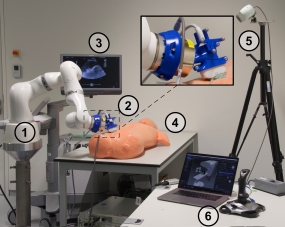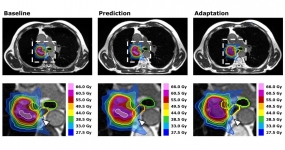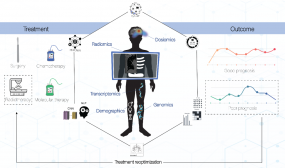Advanced Image-Guided RadioTherapy (E0409)
Group leader: Prof. Dr. Oliver Jäkel (in ch.)

Laboratory setup of robotic ultrasound imaging at DKFZ: 1. Robot „KUKA LBR iiwa med“; 2. Mounting of Ultrasound probe; 3. Monitor of Ultrasound Device; 4. Anthropomorphic phantom “Winfried”; 5. Tracking camera “Polaris Spectra”; 6. MITK-based user interface including Joystick
© dkfz.de
In our group we focus on investigating the potential of using various imaging modalities for image guided radiotherapy (IGRT). One focus is the integration of MR images in the treatment planning and adaption process for hybrid (MR-Linac) as well as offline approaches (shuttle transfer of patients between Linac and MR Imaging device). Especially the shuttle solution allows to include functional MRI or PET images to investigate e.g. biomarkers for early response monitoring during the course of therapy. We contribute to this area with research projects in adaptive treatment planning, advanced dosimetry and dose accumulation, optimization of imaging sequences, optimization of cone-beam CT imaging for direct treatment planning, inclusion of dual energy CT for particle therapy, pseudo CT generation from MRI and advanced anthropomorphic motion phantoms. In our group we center on both the technical aspects of image-guided radiotherapy as well as software solutions and patient-oriented workflows.
Besides CT and MRI we also investigate the potential of robotic ultrasound imaging for IGRT, as a further modality to continuously monitor organ motion with high tissue contrast but without any additional dose to the patient. Within the Heidelberg Institute for Radiation Oncology (HIRO) we also established optical surface guidance for radiotherapy at the Heidelberg Ion Beam Therapy Center (HIT) to facilitate the patient set-up and allow for motion monitoring during beam delivery.
Together with the Department of Radiation Oncology and Radiotherapy at Heidelberg University Hospital, we also contribute to the development of MR-guided particle beam therapy within the ARTEMIS project which is funded by the Federal Ministry of Education and Research (BMBF).
Current research topics
- Optimization of CBCT imaging for direct treatment planning
- Optimization of MR-guided ratiotherapy at the MR-Linac
- Development of advanced anthropomorphic motion phantoms and dosimetry tools
- Treatment planning tools for IGRT and adaptive therapy
- MR-guided particle therapy
- Exploration of MR biomarkers for early response assessment
PUMA Trial

© dkfz.de
Another important project is a multi-centric clinical trial together with the DKTK sites in Munich, Tübingen and Heidelberg, to investigate the potential of adaptive radiotherapy for locally advanced non-small cell lung cancer patients - the PUMA trial. More detailed information about the project follows soon here.
Multi-Omics Integration for Personalized Radiotherapy

© dkfz.de
Personalized Radiotherapy (RT) via artificial intelligence (AI) offers a groundbreaking approach to cancer treatment, but still faces challenges from inconsistent and unstandardized data across multiple centers. By leveraging advanced algorithms, automated checks, and content-based classifications, we are building an AI-based framework for the seamless integration of radiomics, dosiomics, and biomolecular omics. This framework aims at RT outcome prediction through a multi-omics convergence that captures unique physiological traits. It aids in prognosis prediction and guides individualized treatment strategies, representing a significant step towards precise and adaptable patient care in personalized RT, and setting the stage for more effective, individualized treatment paths.
More information is available here!
Recent publications
- Elter A, Rippke C, Johnen W, Mann P, Hellwich E, Schwahofer A, et al. End-to-end test for fractionated online adaptive MR-guided radiotherapy using a deformable anthropomorphic pelvis phantom. Physics in medicine and biology. 2021;66(24).
https://doi.org/10.1088/1361-6560/ac3e0c - Niebuhr NI, Splinter M, Bostel T, Seco J, Hentschke CM, Floca RO, et al. Biologically consistent dose accumulation using daily patient imaging. Radiation oncology (London, England). 2021;16(1):65.
https://doi.org/10.1186/s13014-021-01789-3 - Qubala A, Schwahofer A, Jersemann S, Eskandarian S, Harrabi S, Naumann P, et al. Optimizing the Patient Positioning Workflow of Patients with Pelvis, Limb, and Chest/Spine Tumors at an Ion-Beam Gantry based on Optical Surface Guidance. Advances in Radiation Oncology. 2023;8(2):101105.
https://doi.org/10.1016/j.adro.2022.101105 - Regnery S, de Colle C, Eze C, Corradini S, Thieke C, Sedlaczek O, et al. Pulmonary magnetic resonance-guided online adaptive radiotherapy of locally advanced: the PUMA trial. Radiation Oncology. 2023;18(1):74.
https://doi.org/10.1186/s13014-023-02258-9 - Schwahofer A, Mann P, Spindeldreier CK, Karger CP. On the feasibility of absolute 3D dosimetry using LiF thermoluminescence detectors and polymer gels on a 0.35T MR-LINAC. Physics in medicine and biology. 2020;65(21):215002.
https://doi.org/10.1088/1361-6560/aba6d7 - Seitz PK, Karger CP, Bendl R, Schwahofer A. Strategy for automatic ultrasound (US) probe positioning in robot-assisted ultrasound guided radiation therapy. Physics in medicine and biology. 2023;68(4).
https://doi.org/10.1088/1361-6560/acaf46 - Weidner A, Stengl C, Dinkel F, Dorsch S, Murillo C, Seeber S, et al. An abdominal phantom with anthropomorphic organ motion and multimodal imaging contrast for MR-guided radiotherapy. Physics in medicine and biology. 2022;67(4).
https://doi.org/10.1088/1361-6560/ac4ef8
For a full list of articles, theses etc. from the division, see here.
Contact
Prof. Dr. Oliver Jäkel (in ch.)
phone: +49 6221 42-2420
fax: +49 6221 42-2561
The contact details of all group members are available here.
